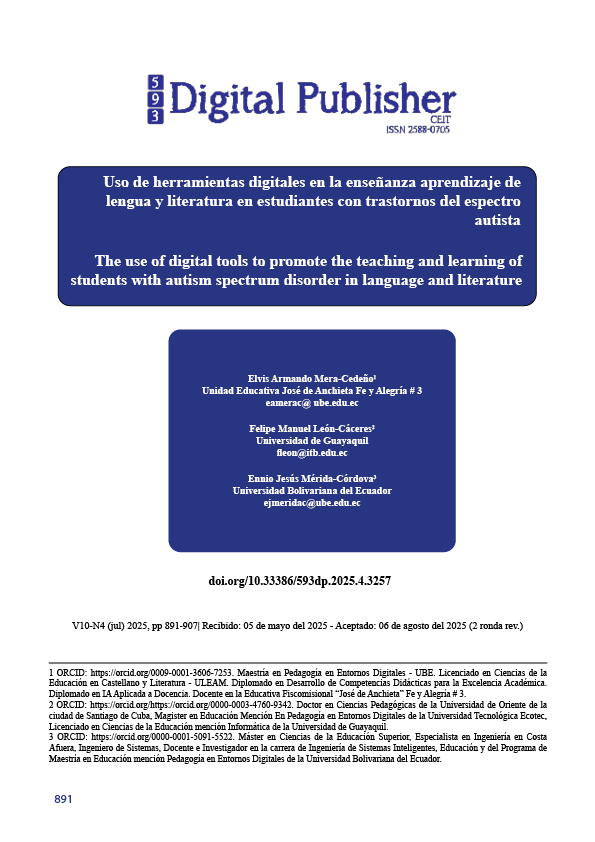Uso de herramientas digitales en la enseñanza aprendizaje de lengua y literatura en estudiantes con trastornos del espectro autista
Contenido principal del artículo
Resumen
Las herramientas digitales se han convertido en elementos esenciales en la educación, facilitando el acceso a diversos recursos y mejorando la gestión docente. Este artículo evalúa la efectividad del uso de herramientas digitales en la enseñanza de lengua y literatura en estudiantes con trastornos del espectro autista (TEA), estos recursos mejoran la comunicación y fomenta la inclusión en el aula, a la vez, analiza la importancia de las herramientas digitales como son pictoselector y araword, porque incentiva la innovación y creatividad de las plataformas digitales: son importante para la lectoescritura por lo que fortalece el proceso de enseñanza-aprendizaje de los estudiantes con trastorno de espectro autista en la unidad educativa fiscomisional de Ecuador en la zona urbana de la ciudad de Manta, provincia de Manabí. Se propone un estudio mixto donde se utilizó encuestas para docentes con el fin de evaluar las necesidades y habilidades de los educadores en la enseñanza a estudiantes con TEA, se realizó un estudio de análisis de datos, entrevista, ficha de observación hacia los docentes, a la vez, se aplicó el método de triangulación y estadísticas descriptivas. El artículo buscó evaluar la efectividad del uso de herramientas digitales (picto selector y araword) en la enseñanza de lengua y literatura en estudiantes con trastornos del espectro autista, por medio de un análisis teórico sobre el uso de herramientas digitales en la educación inclusiva: presentaciones, juegos interactivos mediante plataformas (Kahoot, YouTube, Canva, Araword, Picto selector) resaltando su potencial para atender las necesidades específicas de estos estudiantes, mejorando la comprensión y adaptación del entorno educativo en su desarrollo y aprendizaje.
Descargas
Detalles del artículo

Esta obra está bajo una licencia internacional Creative Commons Atribución-NoComercial-CompartirIgual 4.0.
1. Derechos de autor
Las obras que se publican en 593 Digital Publisher CEIT están sujetas a los siguientes términos:
1.1. 593 Digital Publisher CEIT, conserva los derechos patrimoniales (copyright) de las obras publicadas, favorece y permite la reutilización de las mismas bajo la licencia Licencia Creative Commons 4.0 de Reconocimiento-NoComercial-CompartirIgual 4.0, por lo cual se pueden copiar, usar, difundir, transmitir y exponer públicamente, siempre que:
1.1.a. Se cite la autoría y fuente original de su publicación (revista, editorial, URL).
1.1.b. No se usen para fines comerciales u onerosos.
1.1.c. Se mencione la existencia y especificaciones de esta licencia de uso.
Citas
Valero-Albán, E. M., Pérez Iribar, G., Nazareno Angulo, D., & Rojas Valdés, G. R. (Abril de 2024). Estrategia metodológica para la inclusión de adolescentes con síndrome asperger. Polo del conocimiento, 9(4), 197. https://doi.org/https://doi.org/10.23857/pc.v9i4.6929
Allende Tavío, I. (septiembre de 2021). Beneficios del uso de las TIC para el alumnado con TEA. https://riull.ull.es/xmlui/bitstream/handle/915/27783/Beneficios%20del%20uso%20de%20las%20TIC%20para%20el%20alumnado%20con%20TEA.pdf?sequence=1&isAllowed=y
Bringas, E. C. (28 de abril de 2021). revista vinculando. Herramientas digitales para el desarrollo de aprendizajes: https://vinculando.org/educacion/herramientas-digitales-para-el-desarrollo-de-aprendizajes.html
Carcaño Bringas, E. (28 de Abril de 2021). Herramientas digitales para el desarrollo de aprendizajes. Revista Vinculando. https://vinculando.org/educacion/herramientas-digitales-para-el-desarrollo-de-aprendizajes.html
Carvajal Peñaherrera, H., & Naranjo Sánchez, B. (s.f.). Estudio bibliométrico de las tecnologías para facilitar la comunicación verbal de niños con TEA. Abya Yala UPS, 110. https://doi.org/https://doi.org/10.17163/abyaups.82.617
Cavazos Salaza, R. L. (2021). Las TICCAD como herramientas de innovación en los procesos de enseñanza-aprendizaje. (U. A. León, Recopilador) Las TICCAD como herramientas de innovación en los procesos de enseñanza-aprendizaje
De La Torre Burgos, H. A., Tumbaco Muñoz, M. Y., Vera Panchana, I. E., & Mogrovejo Pincay, R. D. (Julio - Diciembre de 2023). Implicaciones de las nuevas tecnologías en el proceso de enseñanza aprendizaje. Revista Científica multidisciplinaria de la ULEAM, 6(12). https://publicacionescd.uleam.edu.ec/index.php/sapientiae/article/view/507/931
Equipo Especializado en Discapacidad Física. (s.f.). Equipo Especializado en Discapacidad Física: Motora y orgánica. https://equiposespecializados.catedu.es/araword/
Loor García , M. E., & Vega Intriago, J. O. (27 de Diciembre de 2023). Estrategia metodológica para el fortalecimiento de habilidades. Revista Científica Arbitrada de Investigación en Comunicación, Marketing y Empresa REICOMUNICAR, 6(12), 27, 28. https://doi.org/https://doi.org/10.46296/rc.v6i12edespdic.0191
Moirano, A. M., & Lacoboni N., G. (2019). Espectro autista: Historias sociales como andamiaje en ILE. Memoria Académica(15), 4. https://www.memoria.fahce.unlp.edu.ar/art_revistas/pr.12516/pr.12516.pdf
Neurocentro. (17 de Octubre de 2023). Neurocentro, recuperación funcional. https://neuro-centro.com/uso-de-dispositivos-digitales-e-impacto-negativo-en-el-desarrollo-de-los-ninos-y-ninas/
Osorio, L. *. (14 de julio de 2021). qualitas-revista-cientifica . ELEMENTOS DEL PROCESO DE ENSEÑANZA – APRENDIZAJE Y SU INTERACCIÓN EN EL ÁMBITO EDUCATIVO: https://revistas.unibe.edu.ec/index.php/qualitas/article/view/117/124
Pedrero Gónzalez, R., & Rosales Pardo, J. (Julio de 2023). Repositorio Documental CREDOS. https://gredos.usal.es/bitstream/handle/10366/153086/TFM_PedGonR_Comprensi%c3%b3n.pdf?sequence=1&isAllowed=y
Putnam, A., & Sanchez, A. (2019). Digital Skills for the. Investing in America’s Workforce, 5. https://www.investinwork.org/-/media/Project/Atlanta/IAW/Files/reports/digital-skills-for-the-21st-century-workforce.pdf
Rodríguez Chávez , M. H. (22 de Enero - Junio de 2021). Sistemas de tutoría inteligente y su aplicación en la educación superior. Revista Iberoamericana para la Investigación y el Desarrollo Educativo, 12, 6. https://doi.org/https://orcid.org/0000-0002-5421-427X
Tenecota Castro, E. A., Vargas Vásquez, G. L., & Toapanta Morejon, J. W. (Agosto de 2024). RECURSOS DIGITALES PARA LA ENSEÑANZA DE LA COMPRENSIÓN LECTORA EN NIÑOS DE EDUCACIÓN BÁSICA MEDIA. Ciencia Latina Internasional, 8(4), 9237. https://doi.org/https://doi.org/10.37811/cl_rcm.v8i4.13068
Universidad Internacional de la Rioja. (15 de Enero de 2025). UNIR La Universidad del Internet. https://www.unir.net/revista/educacion/metodo-aba/
Vega Sainz, J. A. (Junio de 2020). Legal design Thinking, visuales en los contratos y su validez legal. Revista Jurídica Austral, 1(1), 307 - 318. https://doi.org/jvegasainz@ius.austral.edu.ar
Vinueza Ortega, V. X., Vinueza Ortega, J. G., & Gaón Reina, E. E. (2022). Influencia de las TIC en los Procesos de Enseñanza-Aprendizaje en la Unidad Educativa Atahualpa. TESLA, Revista Científica, 2(1), 63 - 71. https://doi.org/https://doi.org/10.55204/trc.v2i1.45
Martínez Olvera, W., & Esquivel Gámez, I. (2017). Estrategias de lectura comprensiva del inglés para bachilleres, apoyadas en materiales multimedia. Campus Virtuales, 6(1), 1-14. http://www.uajournals.com/ojs/index.php/campusvirtuales/article/view/169
Abreu, Y., Barrera, A., Breijo, T., & Bonilla, I. (2018). El proceso de enseñanza-aprendizaje de los Estudios Lingüísticos: su impacto en la motivación hacia el estudio de la lengua. Mendive, 16 (4), 610-623 .
Torres, G., & Girón, D. (2009). DIDACTICA GENERAL. COORDINACIÓN EDUCATIVA Y CULTURAL CENTROAMERICANA, 9.
Lehman, J. (1998). A featuredbased comparison of software preferences in typically-developing children versus children with autism spectrum disorders. Obtenido de http://www.cs.cmu.edu/People/jef/survey.html
Calle Daza, S. (2018). Diseño de una herramienta didáctica para niños con trastornos del espectro autista - TEA. Universidad Pontificia Bolivariana. http://hdl.handle.net/20.500.11912/3859.
González, M., & López, J. (2023). Comprensión de textos y trastornos del espectro autista: Un estudio sobre el impacto de las ayudas dirigidas a facilitar el control ejecutivo en la comprensión. Gredos. https://gredos.usal.es/handle/10366/153086
Rodríguez, M., & López, A. (2021). Tecnologías y comunicación alternativa: Aplicación de Picto Selector en entornos inclusivos. Ediciones Inclusión.
García, L., Ramírez, J., & Martínez, S. (2022). Tecnologías de apoyo para la comunicación en educación especial: La aplicación de Araword. Editorial Comunicación Inclusiva.
Herrera, L., & López, J. (2021). Nuevas tecnologías en el aula inclusiva: Estrategias para el aprendizaje de estudiantes con TEA en lengua y literatura. Editorial Innovación Educativa.
Martínez, G., & Rivera, F. (2022). Herramientas digitales y aprendizaje inclusivo: Casos de éxito en la enseñanza de la lengua y literatura a estudiantes con necesidades educativas especiales. Ediciones Educa.
Rodríguez, P., García, M., & Torres, S. (2020). Implementación de pictogramas en el aprendizaje de la lectoescritura: Araword y Picto Selector como recursos de apoyo en estudiantes con TEA. Editorial Comunicación Inclusiva.




